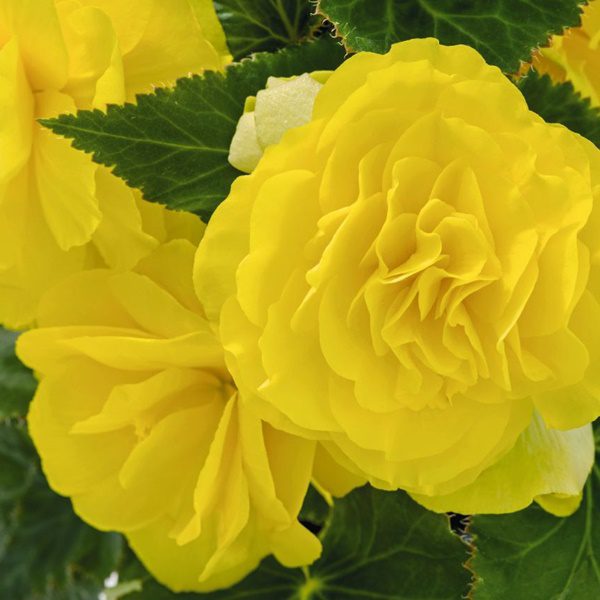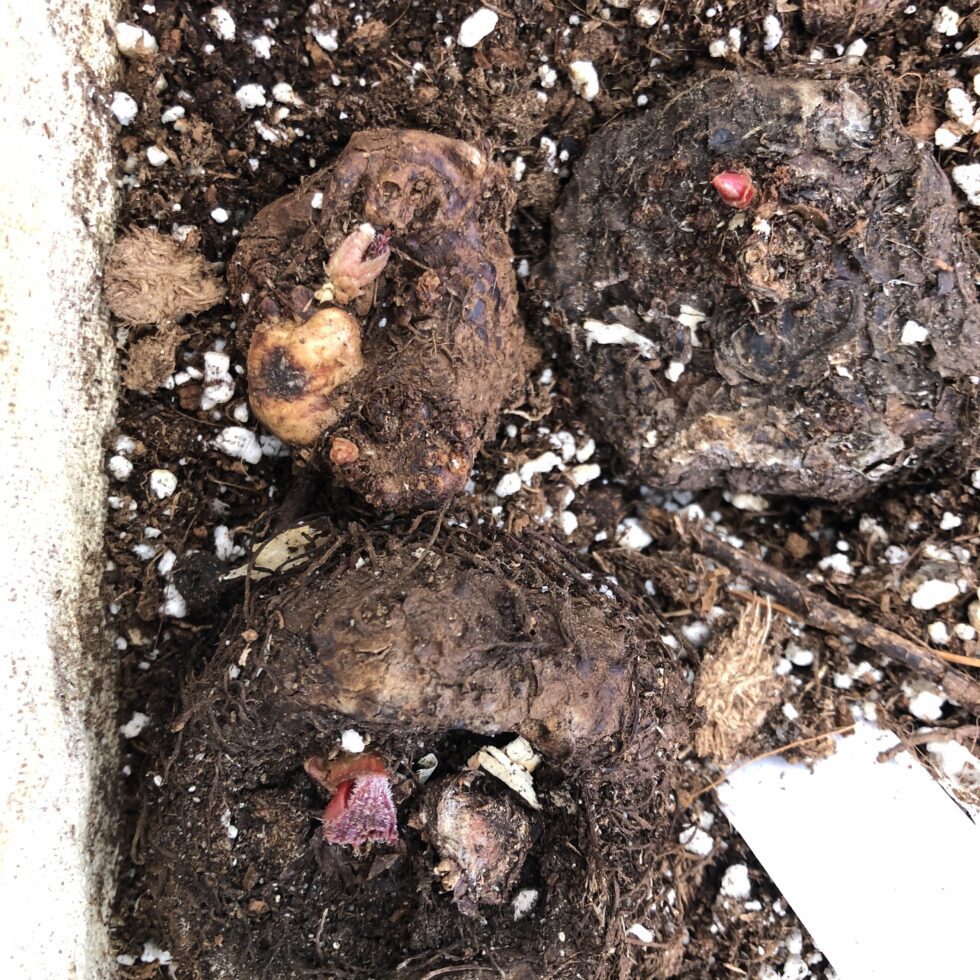Introduction
Tuberhybrida were developed by propagation and hybridization in the 1850’s Victorian times specifically for their large flowers. Parent tubers were discovered in forests of Bolivia and Peru and the Andes of South America. Much of the work to hybridize and cultivate tuberous begonias was done in the 20th century in Europe and North America. In fact, Blackmore & Langdon, located in England, began growing and selling tuberous begonias in 1901, and continue to do so today.
Begonia Tuberhybrida are best known for their showy flowers. They are of various forms, shapes and color. Flowers are mainly classified as Picotee, a flower with a fine edge that is a different color from the main or ground part of the flower. Color of a picotee will start first with the ground color first, and then the color of the fine line edge. Other forms are Bicolor, Camellia and Rose forms, ruffled and serrated.
In addition to flower shape plant types are also recognized. Large-flowered standards are the queens of tuberous begonias. Other variety of forms are the hanging or cascading Pendula, Fimbriata with their double flowers, Marginata also known as the Fascination begonias, Marmorata’s marbled petals, Non-stop begonias used for bedding purposes and Multiflora types which have a multitude of smaller flowers and is a compact plant. There are also wintering flowering and fragrant varieties.
GENERAL REQUIREMENTS
The tuberous root system is what sets this type apart. They become dormant and can be lifted and stored. These begonias are generally grown in plastic or terra-cotta pots and are used as a display. Pendula are usually grown in several types of hanging pots. All have requirements for air circulation, humidity, light and water.
Air Circulation
Tuberous begonias will suffer at any temperature consistently above 86 degrees, whether indoors or out. They thrive on good circulation. Don’t overcrowd, as spacing is crucial to prevent stagnant air. Avoiding stagnant air helps reduce fungal diseases of botrytis and powdery mildew. Consider shelter from wind and rain with a shade house, greenhouse or lathe house.
Humidity
Begonias love a humid atmosphere, but humidity and warmth go together. Increase humidity with pebbles on a tray or watering the area around your plants. Lower temperature and high humidity can be a disaster for rot.
Good Light
Like most begonias, tuberous like light but need shade. They can tolerate direct early morning sun or late afternoon sun, but will burn badly if exposed to the extreme heat and direct sun of midday. Good light levels will ensure the plant flowers well, and is needed for the vibrant, colorful blooms they are known for.
Water
Like all begonias, tuberous will not do well in overwatering conditions. Considerations are water retention in different growing mediums, the size of the plant and tuber, and the container type. A smaller plant should be in a smaller pot. A large tuber/plant can be in a larger pot. Typically, the pot should handle the tuber with a 1” distance from the tuber to the pot wall.
STARTING TUBERS
The start of the growing season for Tuberous is early spring, when the tubers are still dormant. For the most part tubers are taken up and stored in a cool, dry place during the winter. Click here for the article on Storing Tubers in the Winter
Budding Up
There are two things to look for around March or after a freeze occurs. First inspect the tuber for health. They should be firm, pest free and clean. The second step is to check for budding up. You’ll notice the buds of stems or “pinkies” appear. You can encourage this step by moving your stored tubers from the dark cool area into a warmer environment.
Several steps can be taken to start tubers into growth, depending on location and personal preference as well as available bottom heat. There are several other grower treatments to assist budding up, submerging the tuber in warm water, and then place in cold water for 15 minutes each time. Some growers will sterilize the tuber in a bleach solution of ten parts cold water to one part bleach, soaked for up to 15 minutes and rinsed in clean, fresh water.
Some tubers will take longer to bud up. Try placing them on a layer of medium and place your tray on a heating pad or seed pad set at around 75 degrees F.
Soil Medium
Excellent drainage is key. A 50/50 mix of peat, coco coir or a good fresh potting soil and perlite is recommended. Hold off any fertilizer as the emerging roots will burn. The tuber will provide the nutrition needed for starting. Use a new medium, not last year’s old mix if they’ve been left in their containers over the winter. Old soil nutrients have been exhausted and will contain excess salts from last season’s fertilizing.
Put the tubers on at least a 2 1/2” layer of medium and place on a heat source, if available. Or place in a warm, well-lit area. Push the tubers into the mix, bud side up with at least 2” of space all around to allow for good root growth. Then thinly cover with additional mix to encourage them to grow roots all around the tuber surface.
Check for moisture. If pressing your finger into the mix registers damp, do not water. If dry, water lightly. Avoid overwatering as your tubers will rot!
Potting
Assess the size of the tuber to the size of your pot. A larger tuber will have a large root mass and more top growth. They can deal with larger amounts of mix and water.
Smaller tubers, with smaller root masses will be swamped if planted directly into an 8 in. Pot.Pot when budding growth has reached 3-4”. The container should be large enough to hold the root ball with 1” space all around.
Don’t pack the mix, young roots are very fragile. Gently knock the pot on your surface to settle the mix, then water. Again, water with caution and only when dry. Make sure you have good drainage. Note your pot type; plastic will transpire less than a terra-cotta pot.
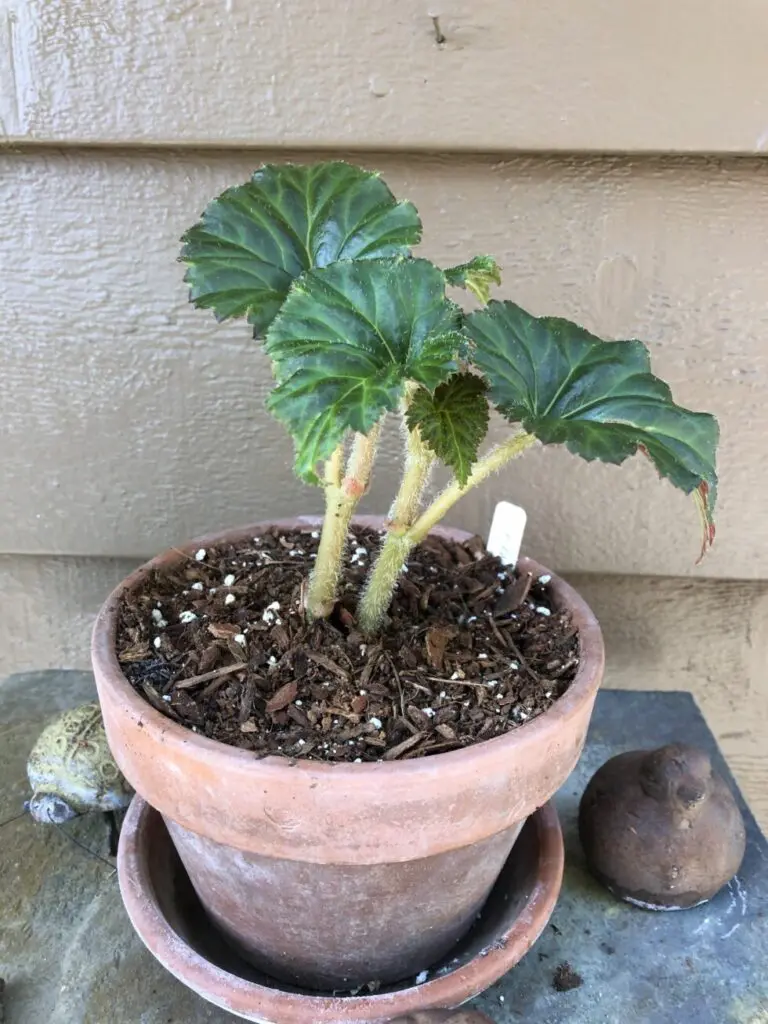
Large Flowered Standards
Shaping the plant
Determine the number of shoots coming from the tuber. On a young tuber you may select one stem. First and second year tubers do better if only one stem is selected; multiple stems will produce smaller flowers and weaker plants. The tuber is also not able to increase its size towards the end of the season.
Begonia stems have a front and back, with flowers forming and facing forward; the pointed leaves indicate the front of the plant. Where the plant is used for display or show, three to four evenly spaced shoots facing outward will give the best results. Surplus stems may be “rubbed off” or use these as basal shoots for propagation. These basal shoots are the easiest type of cutting to propagate. Wiggle the shoot out of the tuber and you might even have a few roots come out with the stem!
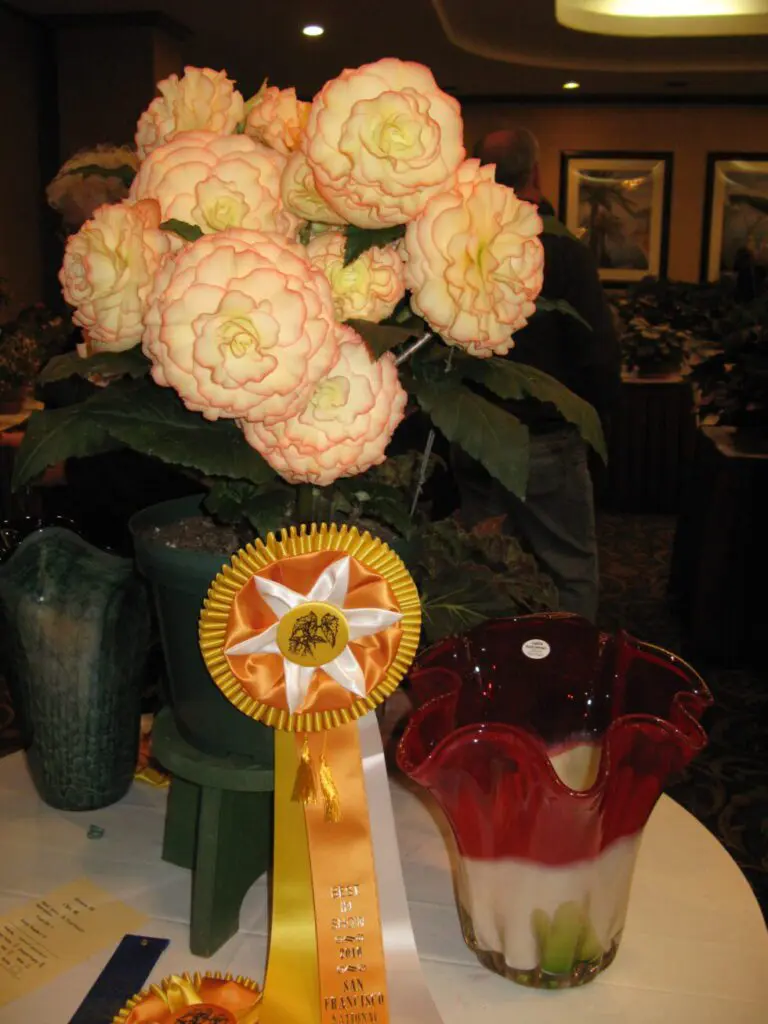
A Best of Show | Photo: Laurel Carlisle
Final Potting and Staking
Some growers prefer to start tubers in smaller pots and graduate to larger pots as the plant grows. If plants are potted in stages, check them 4 to 6 weeks by knocking them out of their containers.
When the roots have reached the edge of the pot it is time to pot into the next size larger. Don’t allow a root bound plant as this will retard growth. Allow another 1” around the root ball.
Smaller tubers typically will be in a 6” pot with the largest tubers in a 10” pot. The final root ball should be set down about 2” below the rim of the new container. This allows for top dressing as fine surface roots appear and the mix compacts down throughout the growing season.
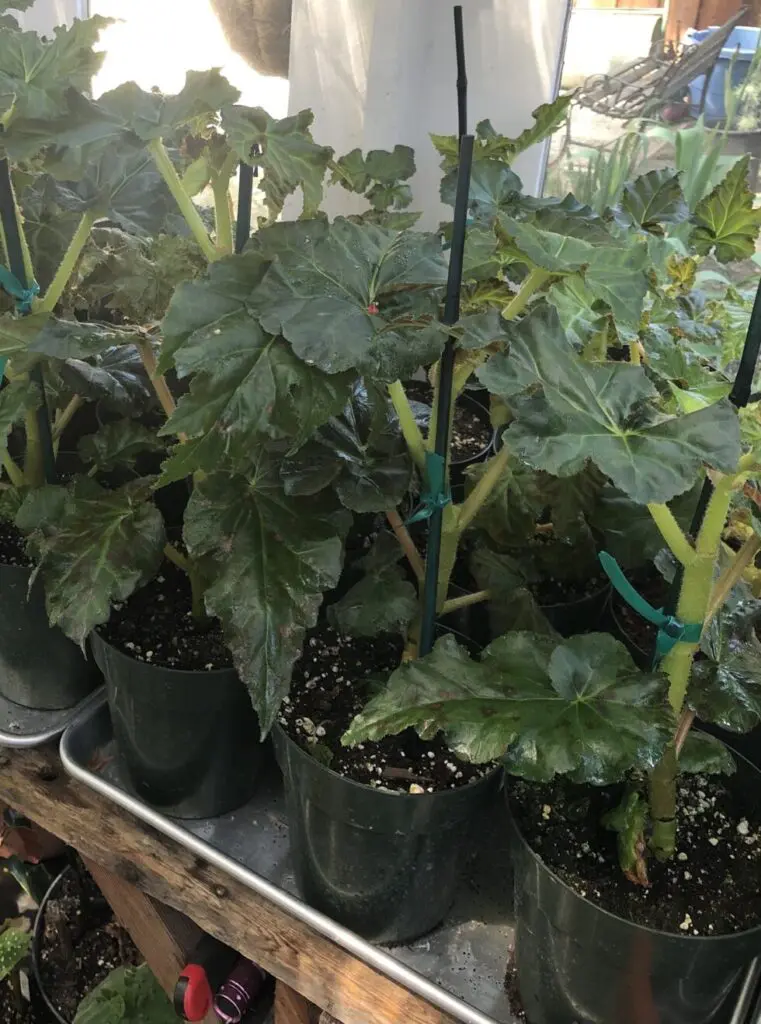
Photo: Rita Nordby
If staking place the stake towards the back of the plant, leaning towards the back of the pot but clear of the tuber, with the tuber also slightly towards the back of the pot. Each stem should have a supporting stake. Square stakes can give a firmer grip in the soil and good support with it up against the stem. Leaning the stakes outward, gives better air movement and more room for flowers. As the stem grows, tie them loosely to the stakes at regular intervals.
Flowers
Remove the flowers until the plant has at least eight to ten leaves. Once buds are left you can determine when the plant will flower. Buds measuring over 1” will fully open after 30-40 more days, depending on variety and weather. Each flower is usually flanked by two smaller females or sometimes a smaller male. The main center flower is the showy male flower. Remove the smaller female flowers as soon as possible to help increase the size of the showy male.
Pendulous or Cascading varieties
Shaping and Flowers
Generally, these begonias have smaller flowers than their upright cousins. But flowering is profuse. Growing and care are similar to the large flowering standards. But these do best hanging, and are more vulnerable to damage by wind. Once they have budded up, plant them directly into their appropriately sized basket. Move them outside only when the daytime temperatures are a consistent 55F. Provided overhead protection should be considered, and hanging from low branched trees can provide enough protection from wind and rain.
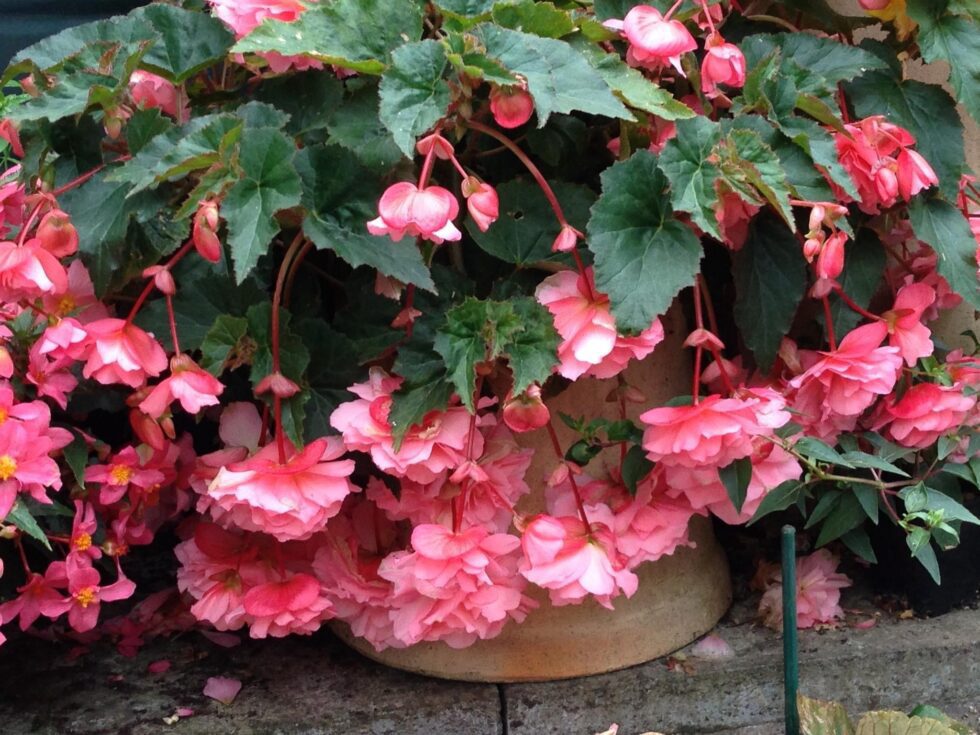
B. ‘Lou Ann’ | Photo: Phil Champion
All growing shoots are left on a hanging plant. When stems are between 6-8” long, all flower buds and growing tips should be removed. This will force the shoots to branch and produce more flowers. This process can be repeated, but flowering will be delayed by 2-3 weeks. No flower pinching is necessary to produce larger male flowers. It is the amount of blooms that make these impressive Pendula varieties spectacular, not the individual flower. No staking or supporting are necessary.
Watering
Hanging baskets tend to dry out more rapidly as they are exposed with more air movement around them. Consider water-retentive crystals or gels or a potting mix with water retentive properties.
Feeding Tuberous Begonias
A regular feeding routine of a fertilizer regime every 10 days to 2 weeks is helpful in retaining plant health throughout the growing season. Be sure to water between fertilizing, with clear, fresh water to wash away any excess salts.
While tubers are waking up from their winter slumber, a solution of a very weak dilution of a balanced foliar feed can be helpful. This feeding will occur for approximately 3 weeks as the sprouts bud and show “pinkies”.
After sprouts bud-up, when the stems are at 1.5 to 2” an application of a diluted 30-10-10 can be used for 2-3 feedings until the plant is ready for pot up. This must be VERY diluted as the roots are developing and very tender. Any excess fertilizer will burn these very young and tender roots. Use clear fresh water between these feedings to flush fertilizer out. When the plants are 3-4” your plant is ready for pot up.
If your mix doesn’t contain a balanced time release fertilizer already, you can mix in a balanced slow release such as Osmocote or Nutricote, in your final potting mix. This will augment the nitrogen in the early growing period.
During the growth of leaves and before flowers begin to bud, increase fertilizer with a diluted balanced foliar feed of 20-20-20. It is important to dilute to a 1/3 to 1/2 strength of the manufacturer’s direction to avoid over fertilizing and burning your roots and leaves. Plain, fresh water between feedings will wash away excess salts.
Once flowering buds have developed and to encourage flower production and overall plant health, switch to a 6-30-30 diluted foliar feed. This solution will encourage flowers and overall plant health until near the end of the season. Too much nitrogen will cause too much dark, leafy growth and diminish the production of flowers. Using plain, fresh water between feedings will wash away excess salts.
Winter Wind-Down
Near the end of season flowers will diminish in size. At this time the plant is putting all its energy into increasing the tuber size, storing energy for start-up in the next growing cycle. An application of potash is helpful, but all other fertilizing should be stopped.
Stop the growing by removing the plant growing tips and any side shoots. Remove all remaining flowers and buds. The stem and foliage should be kept growing as long as possible, with watering decreased. Gradually with colder weather and shorter days the plant will go dormant. At this point all watering is stopped.
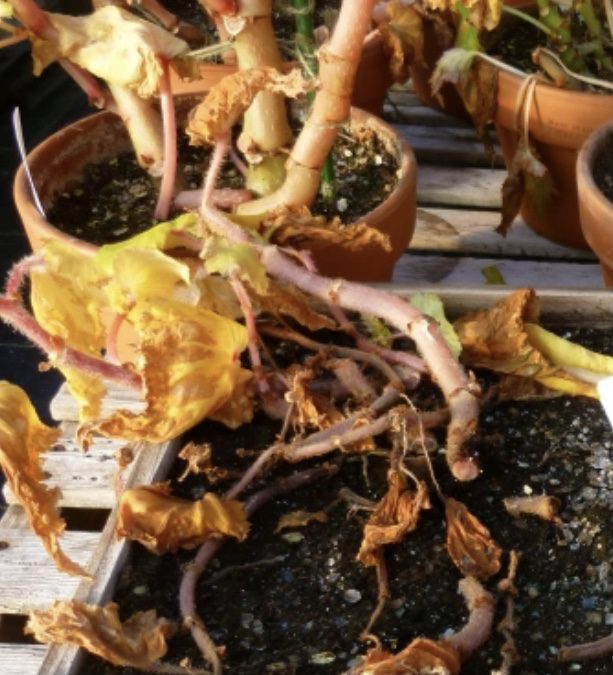
As the leaves and stems drop off, clear the foliage to avoid any rot around the plant. Some will lay the containers on their sides to allow the stems to drop away more easily. Don’t remove the stems from the tuber, as this will only cause damage.
When all foliage has fallen away and the mix is thoroughly dry, the tuber can be removed. Remove all mix, brush the tuber with a soft brush inspecting for health before storing away. Some people keep their tubers in the mix and wintered over. Some growers will dust their tubers with Sulphur before storing. For more info read Storing Tubers for the Winter.

